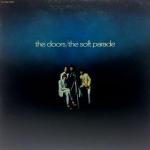This vintage Doors pressing (either on the Elektra Gold or Big Red E Label, nothing else will do) has the kind of Tubey Magical Midrange that modern records rarely reproduce.
Folks, that sound is gone and it sure isn’t showing any sign of coming back.
This Is One of The Records That Did It For Me
Perhaps hearing Dark Side was what made you realize how good a record could sound. Looking back on it over the last forty years, it’s clear to me now that this album, along with scores of others, is one of the surest reasons I became an audiophile in the first place, and stuck with it for so long. What could be better than hearing music you love sound so good?
It’s clearly an album we are obsessed with. We have written extensively about quite a number of them to date. It is our contention that to be any good at this hobby, you have to become obsessed with well-recorded albums and work out the consequences of those obsessions for yourself. We wrote about it here. An excerpt:
As a budding audiophile I went out of my way to acquire any piece of equipment that could make these records from the ’70s (the decade of my formative music-buying years) sound better than the gear I was then using. It’s the challenging recordings by Crosby, Stills, Nash and Young, as well as scores of other pop and rock artists like them, that drove my pursuit of higher quality audio, starting all the way back in high school.
And here I am — here we are — still at it, forty years later, because the music still sounds fresh and original, and the pressings that we find get better and better with each passing year.
That kind of progress is proof that we’re doing it right. It’s a good test for any audiophile. If you are actively and seriously pursuing this hobby, perhaps as many as nine out of ten non-audiophile pressings in your collection should sound better with each passing year.
As your stereo improves, not to mention your critical listening skills, the shortcomings of some of them will no doubt become more apparent. For the most part, however, with continual refinements and improvements to your system and room, vintage pressings will continue to sound better the longer you stay active in the hobby.
That’s what makes it fun to play old records: They just keep getting better!
The Typical Soft Parade LP
The sound of most pressings of The Soft Parade is just plain terrible. The brass that opens side one is often so pinched, compressed, grainy and aggressive it will practically make your hair stand on end. Almost all the post-Big-Red-E reissue LPs sound like they are made from sub-generation EQ’d compressed tape copies, what are commonly called cutting masters. So many reissues have such a similar character that it’s hard to imagine they’re not all sourced from the same bad “master.”
Need I even mention how much better this copy sounds than the recent 180g version from the Rhino Box Set, digitally remastered by Bernie Grundman? That thing is just awful, possibly the worst sounding pressing I have ever heard. The Gold CD Hoffman did for Audio Fidelity would be night and day better. So much for the concept of vinyl superiority. Not with Bernie at the helm anyway.
Add to that the fact that almost every copy you pick up will have a pronounced HONK in the midrange, giving you that not-so-fondly remembered AM radio sound we’ve all heard on copy after incompetently-mastered, pressed-on-cardboard copy. (And the awful Bruce Botnick engineered CDs too; can’t forget those. If you can’t afford the DCC Gold discs for The Doors’ catalog, you are in for some shockingly mid-fi sound.)
